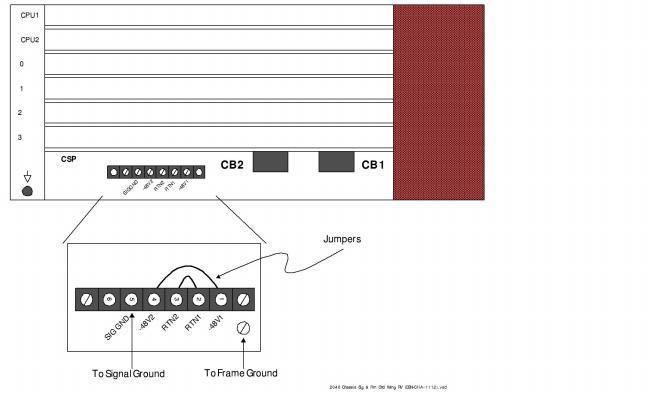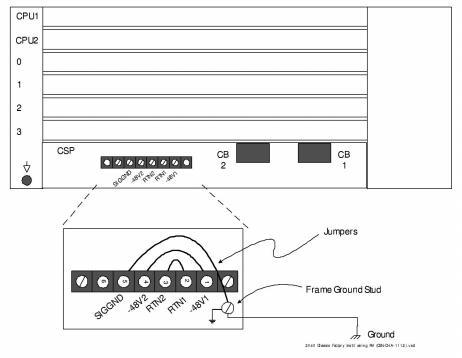
You are here: CSP Hardware Installation and Maintenance > 3 CSP Chassis Installation > Powering CSP 2040

Overview
You connect the external power source to the chassis at the terminal block (Terminal Block Factory-Installed Wiring ) on the Power Input Panel. The factory-installed wiring configuration enables you to connect a single power source to the chassis without adjusting the jumpers.
Figure 3-8 Terminal Block Factory-Installed Wiring

A CSP 2040 with a DC chassis requires the following level of voltage and current to operate.
|
Nominal Voltage |
Amperage |
Input Voltage Range |
|---|---|---|
|
48 V DC |
10 A |
40 V DC to 60 V DC |
The following components are required to power the CSP 2040 chassis:
External power source of 10 A @ 48 V DC, which is not included with the CSP 2040
PSC-60 Power Supply Card(s)
The PSC-60 Power Supply card is shown in PSC-60 Power Supply Card .
Figure 3-9 PSC-60 Power Supply Card
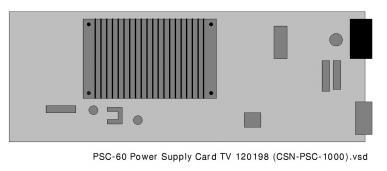
The card has one power module that carries the system power load. The power card imposes a current load limit on the chassis. Therefore, not all configurations can be used in the chassis. The chassis can draw a maximum of 60 A @ 5V.
Circuit breaker switches on the Power Input Panel (Terminal Block Factory-Installed Wiring ) control input power to the Power Supply cards.
Circuit breaker CB1 controls the Power Supply card in the PSC1 slot.
Circuit breaker CB2 controls the Power Supply card in the PSC2 slot.
The two Power Supply card slots are covered by a panel that attaches to the chassis but not to the Power Supply cards.
The slot cover panel provides access to the LED and power switch on the front panel of each Power Supply card. During normal operation, the LED is ON. If the cards power module fails, the LED blinks.
You can install a second Power Supply card for redundancy. In a redundant configuration, the power modules on both cards share the system power load. For a fully loaded system to run properly, one of the modules must be operational.
The chassis supports the following configuration options:
1 power source, 1 Power Supply card
1 power source, 2 Power Supply cards
2 power sources, 2 Power Supply cards
You must install Power Supply cards in the slots labeled PSC1 and PSC2 on the front of the chassis.
For more information about the PSC-60 Power Supply card, refer to the PSC-60 Hardware Product Description.
Installing a Redundant Power Supply Card
You can add a second Power Supply card to provide power card redundancy in case one of the Power Supply cards fails, an external power source fails, or both fail.
The two Power Supply card slots, PSC1 and PCS2, are covered by a card slot panel (Panel for the PSC1 and PSC2 Card Slots ) that attaches to the front of the chassis. This panel is not attached to the installed Power Supply cards. It covers their front panels but provides access to their LEDs and power switches.
Figure 3-10 Panel for the PSC1 and PSC2 Card Slots
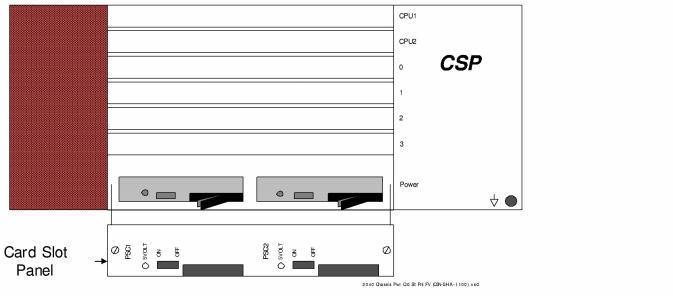
Before installing a redundant Power Supply card, make sure that the power jumpers are connected properly for your power source configuration (single or redundant).
To install a redundant Power Supply card, complete these steps:
1 Press the power switch on the front panel of the redundant card to the OFF position.
2 Press the circuit breaker associated with the redundant card to the OFF position on the power input panel.
3 Remove the front panel from the Power Supply card slots.
4 Insert the redundant card into the unoccupied slot and replace the front panel.
5 Press the circuit breaker on the redundant Power Supply card to the ON position.
6 Press the power switch on the redundant Power Supply card to the ON position.
Connect your chassis to a true earth ground. The grounding harness has a 1-hole connector and a 2-hole connector.
A chassis comes with 8 gauge green/yellow wire for earth ground.
Attached is the 1-hole grounding lug end to the ground (GND) terminal on the rear of the chassis.
Attach the 2-hole grounding lug end to either a grounding point on the mounting rack or the building ground point.
 You must connect your chassis to a true earth ground to maintain signaling integrity and to prevent electrical shock. Do not allow the signal ground to float and never connect a -48 Vdc to ground.
You must connect your chassis to a true earth ground to maintain signaling integrity and to prevent electrical shock. Do not allow the signal ground to float and never connect a -48 Vdc to ground.
The following hardware is required for connecting a power source to the chassis:
14 gauge wire - green for frame ground and signal ground, blue for 48 V, white for 48 V Return
#10 solderless crimp fork terminals for wiring the power source to the terminal block
#10 solderless crimp ring terminal for attaching the frame ground wire to the frame ground stud
Wire each chassis directly to the 48 V fused power source.
 Do not daisy-chain two or more chassis. Do not wire chassis directly to other equipment or to a common bus bar.
Do not daisy-chain two or more chassis. Do not wire chassis directly to other equipment or to a common bus bar.
Most feeders from the -48 V to frames are limited to about 20 A, whereas load distributions support several hundred amperes. Direct wiring to the fused power source eliminates the coupling mechanism, which appears as impedance in the power distribution system. If impedance is not controlled, transient voltages will cause temporary or permanent malfunctions.
Connecting a Single Power Source
Complete the following steps to connect a single external power source to a CSP 2040 chassis.
Always make sure to perform these tasks before you wire the power supply of your CSP.
1 Press the power switches on the Power Supply Card(s) to the OFF position.
2 Press both circuit breakers on the Power Input Panel to the OFF position.
3 Turn the existing external power source OFF and disconnect it from its power supply.
Follow these steps to connect your CSP 2040 to a single, external power source.
 Failure to turn the power OFF at the source may result in electrical shock.
Failure to turn the power OFF at the source may result in electrical shock.
1 Confirm the -48 V DC power source is turned OFF.
2 Remove the terminal block cover from the Power Input Panel.
3 Connect power source wiring (Single Power Source Wiring ).
Leave the factory-installed power jumpers in place.
Attach the power source wires (fitted with solderless crimp terminals) to the terminal block:
|
Negative supply voltage |
48V2 |
|---|---|
|
Positive supply voltage |
RTN2 |
4 Replace the terminal block cover.
5 Turn ON all power to the CSP 2040 as follows:
Reconnect the external power sources and turn them ON.
Press the circuit breakers to the ON position.
Turn the Power Supply cards ON.
Figure 3-11 Single Power Source Wiring
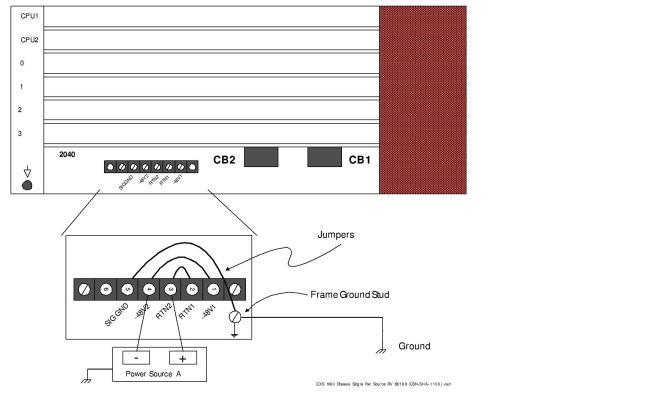
Connecting a Redundant Power Source
If you have a redundant Power Supply card installed, you can add a second power source to the chassis for redundancy.
Always make sure to perform these tasks before you wire the power supply of your CSP.
Press the power switches on the Power Supply card(s) to the OFF position.
Press both circuit breakers on the Power Input Panel to the OFF position.
Turn the existing external power source OFF and disconnect it from its power supply.
To add a redundant power source, complete the following steps:
 Failure to turn the power OFF at the source may result in electrical shock.
Failure to turn the power OFF at the source may result in electrical shock.
1 Confirm the -48 V DC power source is turned OFF.
2 Remove the terminal block cover from the Power Input Panel.
3 Connect the wiring (Redundant Power Source Wiring ).
Remove the factory-installed power jumpers.
Attach the wires from Power Source B (fitted with solderless crimp terminals) to the terminal block:
|
Negative supply voltage |
48V1 |
|---|---|
|
Positive supply voltage |
RTN1 |
4 Replace the terminal block cover.
5 Re-connect and turn ON all power to the CSP 2040 as follows:
Reconnect the external power sources and turn them ON.
Press the circuit breakers to the ON position.
Turn the Power Supply cards ON.
Figure 3-12 Redundant Power Source Wiring
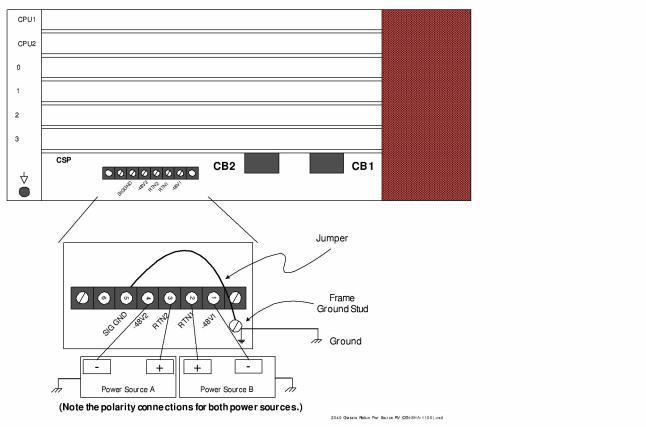
Separating Signal and Frame Ground Wiring
The factory installed wiring configuration joins the signal and frame grounds.
Always make sure to perform these tasks before you wire the power supply of your CSP.
Press the power switches on the Power Supply card(s) to the OFF position.
Press both circuit breakers on the Power Input Panel to the OFF position.
Turn the existing external power source OFF and disconnect it from its power supply.
If you require separate signal ground and frame ground wiring to maintain signal integrity, complete the following steps:
 Failure to turn the power OFF at the source may result in electrical shock.
Failure to turn the power OFF at the source may result in electrical shock.
1 Confirm the -48 V DC power source is turned OFF.
2 Remove the terminal block cover from the Power Input Panel.
3 Remove the factory-installed ground jumper connecting the SIG GND to the frame ground stud (Terminal Block Factory-Installed Wiring ).
4 Attach the signal ground wire (with #10 solderless crimp fork terminal) to SIG GND on the terminal block (Separate Signal and Frame Ground Wiring ).
5 Attach the frame ground wire (with #10 solderless ring terminal) to the frame ground stud (Separate Signal and Frame Ground Wiring ).
6 Replace the terminal block cover.
7 Reconnect the power as follows:
Reconnect the external power sources and turn them ON.
Press the circuit breaker to the ON position.
Turn the Power Supply cards ON.
Figure 3-13 Separate Signal and Frame Ground Wiring
